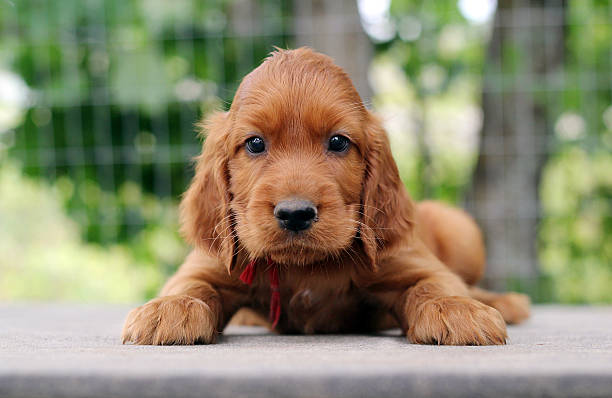Before you bring an Irish Setter home, be sure you are ready to offer it a happy life. You can offer your puppy with a secure and healthy environment by learning more about where to buy, their food needs, how much activity they require, and how to keep them well-groomed.
Table of Contents
Care
Irish Setters are one of the most popular family dog breeds in the United States. Irish Setters were designed to be gun dogs, able to hunt with their owners and capture game without hearing their footsteps, whether fowl or otherwise.
During a hunt, they were supposed to be completely obedient to their owner and heed every instruction. They are extremely bright dogs, albeit they may be a little obstinate at times. Due to their versatility, these dogs are often quite docile canines with lovely coats and temperaments, and they make a great addition to any household.
Keep reading to learn seven specific care advice for Irish Setter puppies if you believe an Irish Setter would be a good breed for you.
Feeding
The amount of food your dog consumes is determined by various factors, including its build, weight, metabolism, degree of exercise, age, and size.
Large-breed puppies have extremely unique dietary requirements, thus choosing the right food for your Irish Setter puppy is critical to its long-term health.
Both too much and too little calcium have been demonstrated in studies to cause irreversible joint injury. Calcium absorption is influenced by a variety of minerals, including phosphorus, vitamin D, and a variety of others. Nutrient levels must be high enough to sustain healthy development while being low enough to keep growth gradual and constant. When deciding what kind of food to give your dog, all of these considerations must be considered.
A commercial super premium food – particularly prepared for large-breed pups – is the finest for Irish Setter puppies, in my opinion. However, not all commercial puppy meals are made equal; instead of relying on marketing promises on the front of the bag, research the ingredients and nutritional facts on the back before making a choice! Websites like www.dogfoodanalysis.com can help you better comprehend dog food components.
Food & Diet Requirements
- Feeding a poor quality meal, although giving a low calcium component, also has a low energy density, necessitating the pup to eat more before feeling full, resulting in a high calcium absorption.
- In young large-breed puppies, the goal is for them to grow’slower but stronger.’ Thus, rather than allowing unfettered access to food, it is critical to feed the appropriate daily intake in small, frequent meals (2–3 times each day). Nutritional imbalances can occur even if a large-breed puppy formulation is given “ad lib.” Because each dog is unique, the amount of food should be adjusted accordingly. A puppy less than 6 months should have a body condition score that is on the thin side of normal. They should have the appearance of gangly youths.
- Do not elevate your puppy’s feeding bowl from the ground. It is a frequent misconception that elevating food bowls can help dogs avoid bloat. In fact, studies have showed that when dogs are served from high bowls, they are more prone to swallow air, which is one of the risk factors for bloat. Stainless steel bowls are generally the most hygienic and simplest to clean.
- Your dog should always have access to fresh, clean water.
- Do not put your dog through too much exercise. Heavy exercise, leaping, and long distance running will injure the growing joints. Before taking your dog on a marathon run with you, wait until he is skeletally mature.
Nutrition
- Choose a preservative-free large-breed puppy food with human-grade, high-quality ingredients.
- Protein sources, such as chicken or beef, should be among the first components in any dish. If the first component in the cuisine is a carbohydrate, such as maize meal or rice, skip it.
- Look for a food that has a protein content of 25% or more.
- The fat content of the diet should be reasonable, ranging from 10% to 16%.
- Calcium levels should ideally range from 0.7 to 1.2 percent. For your Irish Setter puppy, it should not be more than 1.5 percent.
Weight
| Month of Age | Male Irish Setter Weight (rounded average) | Female Irish Setter Weight (rounded average) |
| 4 Months | 30 pounds | 28 pounds |
| 6 Months | 40 pounds | 38 pounds |
| 8 Months | 50 pounds | 46 pounds |
| 10 Months | 56 pounds | 52 pounds |
| 12 Months | 60 pounds | 56 pounds |
| 14 Months | 64 pounds | 58 pounds |
| 16 Months | 68 pounds | 58-60 pounds |
| 18 Months | 70-72 pounds | 58-60 pounds |
Grooming
Despite their gleaming mahogany coats, Irish Setters do not require much maintenance. Brushing them twice to three times a week with a soft bristle brush or a pin brush is recommended. A long-toothed dog comb might also be beneficial if your dog is an outdoor pet that is prone to knots and matting.
Irish Setters shed an average quantity of hair, which fluctuates throughout the year according on the season. To keep this dog’s lovely coat of long, silky hair in good shape, groom it three times a week. A slicker dog brush is a great grooming item for removing knots and stray hair from your Irish Setter’s coat. Individual plastic pins serve as bristles on a slicker brush. Plastic pins are gentle on your dog’s skin while stirring up natural oils and bringing shine to the coat.
Irish Setter Puppies – Before You Buy
The history of the Irish Setter may tell you a lot about what to expect if you get one as a pet. The key word here is “spirited.” This dog need regular exercise. Given his past, it is worth noting that he has a high prey drive. He will chase an animal that flees from him, giving the dog a strong desire to travel.
Price
Expect to pay a bit more if you want an Irish Setter puppy that is registered with the American Kennel Club. Reputable breeders usually charge between $800 and $1200 for these puppies. Puppies at this price point are thought to be of good quality and have been bred to be show dogs. In some states expect to pay up to $1500.
Only purchase from reliable vendors who conduct the required health exams.
Breeders
Are you looking for a purebred Irish Setter puppy to add to your family? The Irish Setter is a unique dog breed that ranks in the top 80 dog breeds in the United States. You may have to travel to find a decent quality breeder, depending on where you reside. However, a happy and healthy red is preferable than an unhealthy red, so it is worth the extra work. Only healthy dogs will be bred by good breeders, and their puppies will be socialized and raised with affection.
Please visit: https://www.facebook.com/IrishSetterBreeders/
Dog Rehoming and adoption
If you want to see Irish Setters for adoption, look at rescue organizations for the breed. There are benefits of adopting a full-grown setter dog.
If you are thinking about getting a puppy, it is a good idea to research whether hereditary diseases are frequent in the breed you are considering. You could also inquire whether your shelter or rescue has information on the physical health of the parents and any relatives of your possible puppy.
The cost of these puppies varies depending on the rescue organization you work with. Remember to select a breeder or a rescue that has a strong reputation for providing the greatest care for its dogs, whether you go with a breeder or a rescue.
The Irish Setter Club of America maintains a volunteer club named “Irish Setter Rescue.” This organization works relentlessly to locate warm “forever” homes for Irish Setters that are homeless or displaced.
Conclusion
As you have discovered, having an Irish Setter is not without its difficulties. He will need to be disciplined right away. Humans are certain to get along with everyone in the family, but other pets are not. There is also a commitment of time and effort. The latter two are the most important. If you are not confident in your ability to provide for them on a constant basis, this breed is not the best fit for your lifestyle.



